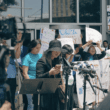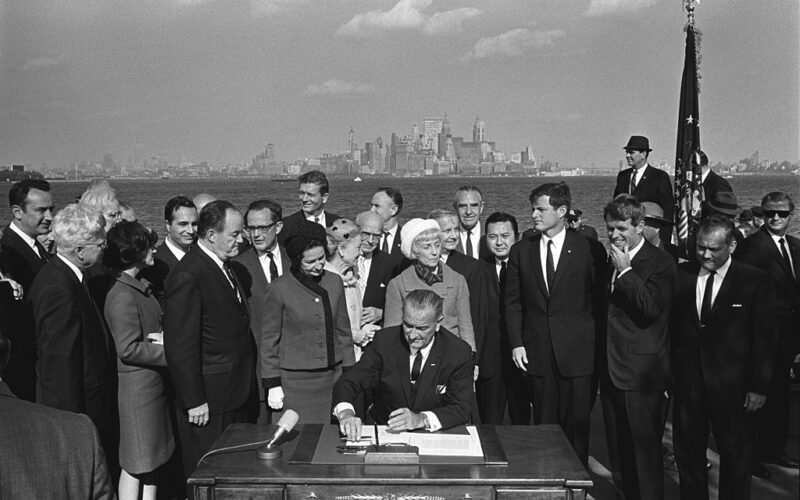Sign up here to receive The Yappie's weekly briefing on Asian American + Pacific Islander politics and support our work by making a donation.
People around the world have long seen America as a land of opportunity, home of the American Dream. The promise reflects the array of economic and political forces shaping the immigration that established the Asian American and Pacific Islander community in the U.S. today—whether by free will or force.
Journeys to the continental U.S. have looked very different for different ethnic communities, varying drastically for East, South, Southeast Asians and Pacific Islanders.
Prior to the Immigration and Nationality Act of 1965 (also known as the Hart-Celler Act), immigration from Asia and the Pacific Islands was limited by quota systems and other restrictive policies that privileged Western European immigration and excluded Asians and Pacific Islanders—like the infamous Chinese Exclusion Act of 1882.
But policies like the 1965 legislation and U.S. foreign influence in the Pacific Islands and Southeast Asia eventually shaped the face of Asian America today. A 2021 Pew Research Center report found that roughly 70% of Asian American adults were born in another country. Roughly 16% of Native Hawaiians and Pacific Islanders are also foreign born under the Asian Pacific Institute’s parameters.
Opening the doors to skilled labor: The Immigration and Nationality Act of 1965 granted immigration visas to family members reuniting with those already in the United States as well as to “to qualified immigrants who … because of their exceptional ability in the sciences or the arts will substantially benefit prospectively the national economy, cultural interests, or welfare of the United States”—creating a highly-educated and STEM-labor dominated Asian American immigrant population.
- The Act was motivated by the Cold War panic in the 60s, in the hopes that bringing in more educated labor would aid the United States and demonstrate its positioning as a free democratic society in contrast to communist governments.
- East and South Asian populations from China, India, and Japan were primarily the ones immigrating to the United States immediately after the passage of the Hart-Celler Act. 10 years after the passage of the act, the Chinese American population almost doubled, according to the Library of Congress.
Refugee movements: In the mid-1970s, the ethnic makeup of Asian America changed once again as waves of Southeast Asian refugees came to the United States in the wake of the Vietnam War, the Secret War in Laos, and the Khmer Rouge. More than 300,000 refugees from Vietnam, Laos, and Cambodia came to the U.S. between 1975 to 1979.
- Refugees were fleeing “political persecution and violence” that continued in the aftermath of the wars and bombings in Southeast Asia, according to the Southeast Asian Resource Action Center.
- During the Vietnam War the U.S. military also occupied Laos, bombing communist supply lines on both sides of the Vietnam-Laos border. The U.S. military dropped almost 2 million tons of ordnance (weapons, bombs, and related equipment) during the Secret War in Laos. This made the country, on a per-person basis, the most bombed nation in history, according to NBC News.
- When the Vietnam War ended in 1975, hundreds of thousands of Vietnamese refugees fled the country and came to the United States. The same year in Cambodia, the Communist-led regime of the Khmer Rouge began their brutal genocide of the Cambodian people, leading to the resettlement of Cambodian refugees in the United States as well.
However, upon arriving in the United States, many Southeast Asian refugees were discriminated against and lived in low-income, under-invested neighborhoods that lacked institutional and federal resources.
- The conditions of their arrival to the United States compounded with the government’s underinvestment in SEA populations has contributed to the socioeconomic disparities between East Asian and Southeast Asian Americans.
- The average hourly wages earned by AAPIs in 2019 was $30.73, but Vietnamese, Filipino, and Thai populations all made hourly wages below that average with Cambodians making an average of $23.12 per hour, according to the Economic Policy Institute.
Pacific Islander migration: The Hart-Celler Act not only marked an increase of East and South Asian populations in the U.S., but it also opened the doors to larger numbers of Pacific Islander immigrants to the U.S. mainland. The Pacific Islander population grew 41 percent between 1980 and 1990— from 259,566 to 365,024, according to a census report.
- Immigrants were influenced by a variety of factors, including mounting pressures of climate change, Mormon proselytization, and academic opportunity.
- The impacts of climate change and natural disasters continue to force migration of Pacific Islanders today. Climate change impacts areas like the Marshall Islands with disproportionate effects, with differences of 0.5 degrees Celsius resulting in rising sea levels, a decline in water quality, outbreaks of diseases that thrive in warmer conditions, and more that all influence migration from the Islands to the mainland U.S.
Migration differed within the Pacific Islander diaspora, with waves of different Pacific Islander ethnic groups coming at different times.
- In 1972, Samoan authorities estimated that roughly 500 Samoans were leaving each year and that American Samoans residing in Hawai’i and the U.S. mainland outnumbered domestic populations by a ratio of almost two to one, according to The Journal of Pacific History.
- Early Samoan communities formed on the West Coast in the 50s when the U.S. Navy reassigned Samoan personell from Hawai’i to various cities between Seattle and San Diego. After World War II, many Samoans also moved to San Francisco to work on the Hunters Point Naval Shipyard.
- Samoan churches that appeared in these communities drove further migration, with the Mormon Church encouraging its Samoan members to join other Polynesians in Southern California.
- Many Samoans who were educated in the islands migrated to the U.S. mainland seeking greater educational and economic opportunity, leading to a consistent outsourcing of Samoan skilled labor to the mainland from the 50s to 70s. Samoans were able to earn almost three times the amount of income for employment and factory wages on the mainland compared to what they could earn on the islands, according to The Journal of Pacific History.
Most of the 1970s Pacific Islander immigrants were Samoan, but there were large waves of emigration from Fiji in the 1980s and 2000s, Most of the 1970s Pacific Islander immigrants were Samoan, according to the International Organization for Migration.
- Fiji achieved independence from the British crown in 1970, becoming an independent nation in the British Commonwealth. The independent government was dominated by an Indigenous Fijian population that treated the country’s significant Indo-Fijian population—formed from the over 60,000 Indian indentured laborers brought to the islands between 1876 and 1916 under Fiji’s first colonial governor—as second-class citizens.
- The marginalization ultimately caused a steady stream of migration. In 1987 and 2000, newly elected multiracial governments were overthrown by coups restoring ethnic Fiji rule, creating political instability that further boosted emigration.
Note, though, that Census data isn’t always accurate, especially when it comes to Pacific Islander populations. For 20 years, Hawaiians were the first and only Pacific Islander group listed separately on the census due to their status as a U.S. state. This changed in 1980 when the census began including “Guamanian” and “Samoan” on the questionnaire.









